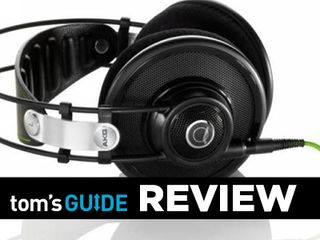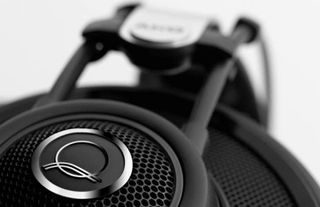AKG Q 701 Quincy Jones Headphones Review
The AKG Q 701 headphones offer impressively accurate audio in a unique and comfortable design.
Why you can trust Tom's Guide

The headphone market has become saturated with celebrity-endorsed products that usually feature some sort of gimmick to make them stand out in the crowd. Not so with the AKG Q 701 Quincy Jones Signature Line Reference-Class Premium Headphones. All you'll find here is a set of headphones with an interesting design, a comfortable fit and natural, accurate sound. Priced at $199, the Q 701s are music to an audiophile's ears and wallet.
Design

AKG has taken a less-is-more approach with the Q 701 to dramatic effect. The headband is comprised of a pair of slim black metal arches that extend into a disc on the earplate. The arches are also held in place by two pairs of lime green clamps. If the admittedly eye-catching lime green isn't your thing, the Q 701s are available in white and jet black.
More: Best Headphones
A black leather headband with green stitching rests just below the arches, held in place by two plastic strips fastened to a lime green slider on each side of the band. The top of the band is imprinted with the name of legendary producer Quincy Jones. The back of the slider is attached to a pair of black elastic bands used to adjust the band for a comfortable fit. The earcups are padded in sensual black velour, adding a touch of luxury.
Measuring 4.5 inches across, the bright green perforated plastic earplates easily enveloped the sides of our head. The somewhat harsh green is broken up by a pair of black rings. A smaller, light green ring protrudes from the middle of the earplates. A black metal cap tops the ring with a chrome-lined Q emblem in the center. A rather large port is located at the bottom of the left center ring for the accompanying 9.8- and 19.6-feet audio cables.
Similar to the HD 598s, the Q 701s don't ship with a storage case, which is fine since they aren't made for use outdoors. However, it would have been nice to have a place to store the extra cables and adapters.
Comfort

Wearing the circumaural Q 701 is a little like wearing a velvety pillow over your ears. Despite the somewhat unique band adjustment system, we never felt any pressure or pinching, even after four hours of wear. In fact, aside from the steady stream of music, we almost forgot that we were wearing headphones. Anyone in the near vicinity of the cans will notice, however, as reference headphones are notorious for their sound leakage.
Thanks to its barely there design, the AKG Q 701 weighs 8.25 ounces, noticeably lighter than the competing Sennheiser HD 598 headphones (9.52 ounces).
Audio Cable
AKG ships the Q 701 headphones with a 9.8-foot audio cable and a 19.6-foot cord. Each lime green cord begins with a three-pin connector that snaps into the audio jack. The cable is held firmly in place until a small black button on the lower end of the connector is depressed, allowing you to safely remove it.
Both sets of cables terminate in a 3.5mm plug. AKG also included a screw-on 6.3mm adapter for those times you want to enhance your listening experience with an amp or digital-to-analog converter.
MORE: Our Favorite Soundbar Speakers
Performance
As the name suggests, the AKG Q 701 Quincy Jones Signature Line Reference-Class Premium Headphones feature an open-ear design. This allows air to seep in, which lowers resonance for a more natural sound and better audio fidelity. AKG also outfitted the oversized cans with its flat-wire voice-coil technology for delivering accurate sound. A patented varimotion two-layer diaphragm is designed to deliver accurate bass and crisp highs, while neodymium drivers reduce distortion.
During our testing, the Q 701 headphones offered accurate audio with wide, spacious soundscapes. However, the volume and the bass were wanting compared with the Sennheiser HD 598s.
When we played John Coltrane's rendition of "My Favorite Things" on the Sennheiser, we heard fairly loud audio with smooth saxophone and bass. But what stood out to us was the spatial audio that sounded like we were in the room with the musicians. The soundscape was transparent enough that we could pick out specific components of the track to follow. Still, the Sennheiser delivered a richer performance, with fuller, louder audio.
On Quincy Jones' "Moody's Mood for Love," the producer's headphones faithfully reproduced James Moody's sultry sax and Rachelle Ferrell's sizzling soprano. But the details impressed most, with the Q 701s giving us a swelling violin against the gentle tickling of the keyboard ivories. The 598s offered warmer tones, particularly on the vocals. However, the audio seemed somewhat confined on the 598s compared to the Q 701s, which sounded more three-dimensional.
We tested the lows on both pairs of headphones with Erykah Badu's "The Healer." The Q 701 offered crisper bass, but the highs sounded somewhat distant. The low end was deep on the 598s without being overwhelming, allowing ample space for the zills and zitar.
Verdict

From Frank Sinatra to Michael Jackson, Quincy Jones knows how to pick a musical winner. The streak continues with the AKG Q 701 Quincy Jones Signature Line Reference-Class Premium headphones. The unique design affords a comfortable fit while AKG's technology creates natural audio with a wide soundscape that audiophiles will appreciate.
However, these cans are a little weak on the bass and aren't as loud as the $186 Sennheiser HD 598 headphones. Overall, audiophiles looking for a comfy pair of reference headphones with a wide soundscape will be well-served in giving the Q 701s a long, leisurely listen.
Follow Sherri on Twitter and Google Plus. Follow us @tomsguide, on Facebook and on Google+.
Sign up to get the BEST of Tom’s Guide direct to your inbox.
Upgrade your life with a daily dose of the biggest tech news, lifestyle hacks and our curated analysis. Be the first to know about cutting-edge gadgets and the hottest deals.
Sherri L. Smith has been cranking out product reviews for Laptopmag.com since 2011. In that time, she's reviewed more than her share of laptops, tablets, smartphones and everything in between. The resident gamer and audio junkie, Sherri was previously a managing editor for Black Web 2.0 and contributed to BET.Com and Popgadget.

